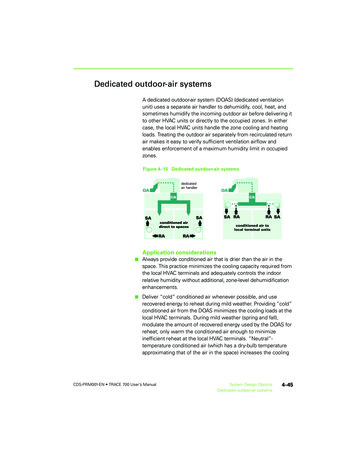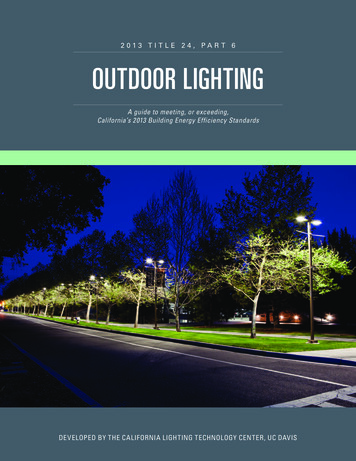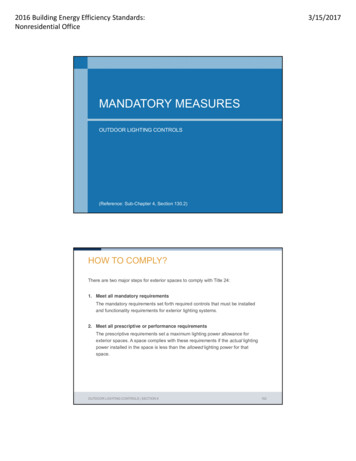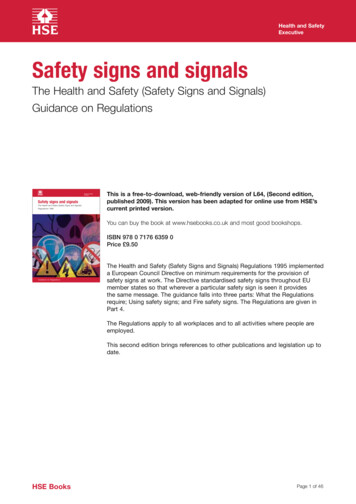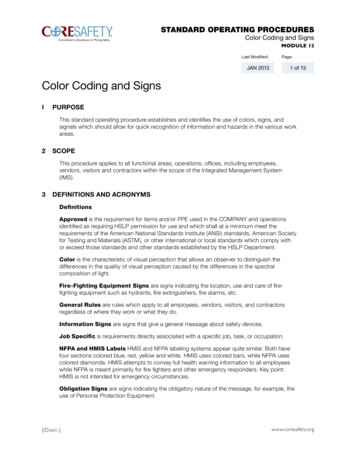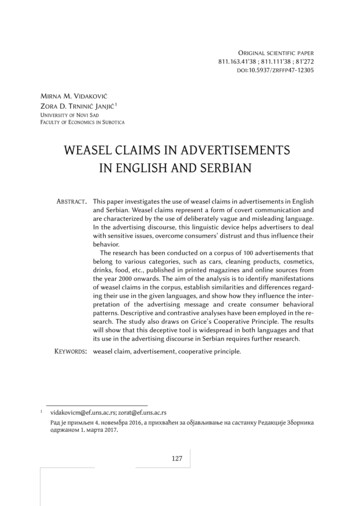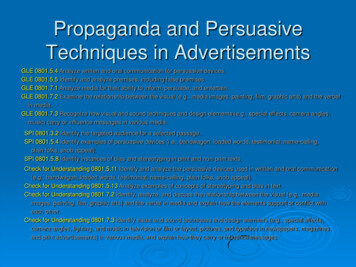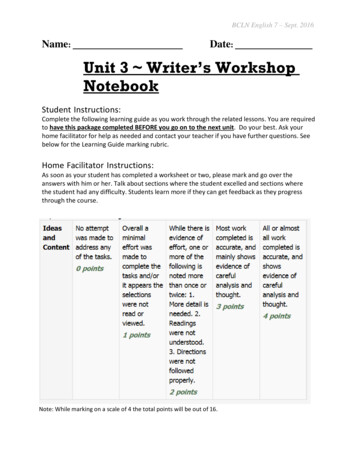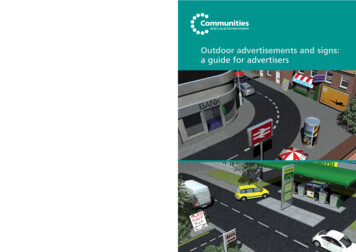
Transcription
Outdoor advertisements and signs:a guide for advertisers
Outdoor advertisements and signs:a guide for advertisersJune 2007Department for Communities and Local Government
Department for Communities and Local GovernmentEland HouseBressenden PlaceLondonSW1E 5DUTelephone: 020 7944 4400Website: www.communities.gov.uk Crown Copyright, 2007Copyright in the typographical arrangement rests with the Crown.This publication, excluding logos, may be reproduced free of charge in any format or medium for research, privatestudy or for internal circulation within an organisation. This is subject to it being reproduced accurately and not usedin a misleading context. The material must be acknowledged as Crown copyright and the title of the publicationspecified.Any other use of the contents of this publication would require acopyright licence. Please apply for a Click-Use Licence for core material at www.opsi.gov.uk/clickuse/system/online/pLogin.asp, or by writing to theOffice of Public Sector Information, Information Policy Team, St ClementsHouse, 2-16 Colegate, Norwich, NR3 1BQ. Fax: 01603 723000 or email: HMSOlicensing@cabinet-office.x.gsi.gov.ukIf you require this publication in an alternative format please email es and Local Government PublicationsPO Box 236WetherbyWest YorkshireLS23 7NBTel: 08701 226 236Fax: 08701 226 237Textphone: 08701 207 405Email: communities@twoten.comor online via the Communities and Local Government website: www.communities.gov.ukJune 2007Product Code: 07HC04607
IntroductionOutdoor advertisements and signs: a guide for advertisersAdvertisement controlThis booklet, prepared by Communities and Local Government, aims toexplain to everyone who wants to display an outdoor advertisement howthe system of advertisement control works in England.Because you may find the system quite complicated at first, the booklet isarranged in separate sections and there are numerous illustrations whichmay show you how the system affects the type of advertisement you wantto display.The main sections in the booklet explain:G How the advertisement control system worksG What advertisements are normally permittedG What advertisements need specific permission and how to obtain itG How planning authorities may control the display of advertisements insome special cases is explained in the Appendix.This booklet is intended only to give advice. It does not state the law.3
Outdoor advertisements and signs: a guide for advertisersHow the Advertisement Control System WorksRegulations for EnglandThe advertisement control system in England consists of rules made by theSecretary of State, which is part of the planning control system. The presentrule is the Town and Country Planning (Control of Advertisements) Regulations2007 which has been in force since 6 April 2007.If you need a copy of these rules, you can buy one from your nearestStationery Office bookshop; you should ask for Statutory Instrument 2007No 783. There is also an official Circular and Planning Policy GuidanceNotes, produced by Communities and Local Government, which you mayfind helpful. You should ask for Communities and Local GovernmentCircular No 03/2007 and DOE Planning Policy Guidance(PPG) Note No 19.Who controls outdoor advertisements?Throughout England, local planning authorities are responsible for theday-to-day operation of the advertisement control system, and for decidingwhether a particular advertisement should be permitted or not. For thispurpose the local planning authority for your area will normally be thedistrict council, the County Council or the London borough council if you livein the Greater London area. But there are two exceptions to this arrangement:G if your advertisement is to be displayed in any National Park, the planningauthority is the National Park authority, or if it is to be displayed withinthe Broads area then the planning authority is the Broads authority;G if your advertisement is to be displayed in an urban development area,the planning authority normally is the Urban Development Corporationfor that area.If the planning authority refuse consent for your advertisement, or requireyou to remove an existing advertisement, you have a right to appealagainst their decision. In England, this appeal is to the Secretary of State.The operation of the appeal system is described below.What is an ‘advertisement’?The advertisement control system covers a very wide range of advertisementsand signs including:G posters and noticesG placards and boardsG fascia signs and projecting signsG pole signs and canopy signsG models and devicesG advance signs and directional signsG estate agents’ boardsG captive balloon advertising (not balloons in flight)G flag advertisementsG price markers and price displays4
How the Advertisement Control Sysytem WorksGGtraffic signstown and village name-signsMemorials and railway signals are not regarded as advertisementsThree different groups of outdoor advertisementTo enable you to understand more easily whether you need the planningauthority’s permission for the outdoor advertisement you want to display,this booklet divides all advertisements into three main groups, which areexplained in more detail later on. These groups are:G advertisements which the rules exclude from the planning authority’sdirect control;G advertisements for which the rules give a ‘deemed consent’ so that theplanning authority’s consent is not needed, provided your advertisementis within the rules (see page 10); andG advertisements for which the planning authority’s ‘express consent’ isalways needed.Three areas where special rules applyBecause there are some places in our cities and towns and many parts of thecountryside in England which are especially vulnerable to the visual effectsof outdoor advertisements, all planning authorities have three special powerswhich enable them to achieve a stricter control over advertisements thanthey can achieve in the ordinary way. These powers are:1. to define an Area of Special Control of Advertisements;2. to remove from a particular site or a defined area the benefit of thedeemed consent normally provided by the rules; and3. to require a particular advertisement, or the use of a site for displayingadvertisements, to be discontinued.The way in which the planning authority propose to use the first and secondof these powers must be formally approved by the Secretary of State beforeit is effective; and there is a right of appeal to the Secretary of State againstthe planning authority’s use of the third power (a ‘discontinuance notice’).The ‘standard conditions’All outdoor advertisements must comply with five ‘standard conditions’.They must:G be kept clean and tidyG be kept in a safe conditionG have the permission of the owner of the site on which they are displayed(this includes the Highway Authority if the sign is to be placed onhighway land)G not obscure, or hinder the interpretation of, official road, rail, waterwayor aircraft signs, or otherwise make hazardous the use of these typesof transportG be removed carefully where so required by the planning authority.5
Outdoor advertisements and signs: a guide for advertisersAdvertisements Which are Normally PermittedConditions for display without applicationAn outdoor advertisement is permitted for display without the planningauthority’s specific consent if:G the effect of the rules is to exclude it from direct control; orG it comes within the provisions of one of the 14 classes of deemedconsent specified in the rules.If your advertisement is not permitted in either of these ways, you mustfirst obtain the planning authority’s consent before you display it.The description of advertisements which follows may not include all theconditions and limitations which apply to a particular class, and you areadvised to consult the Regulations for all these details.Advertisements which are excluded from direct controlThere are 9 different classes of advertisement which are excluded fromthe direct control of the planning authority provided certain conditionsare fulfilled. These categories are:1. Advertisements displayed on enclosed land. These would incudeadvertisements inside a railway station forecourt, or inside a bus stationor sports stadium or shopping mall (see illustrations 1 and 2 ).16
Advertisements which are normally permitted22. Advertisements displayed on or in any vehicle or vessel which is normallymoving (see illustrations 3 and 4 ).347
Outdoor advertisements and signs: a guide for advertisers3. Advertisements which are an integral part of a building’s fabric(see illustration 5 ).4. Advertisements in the form of price tickets or markers, trade-nameson branded goods, or displayed on petrol pumps or vending machines.These advertisements must not be illuminated, nor exceed 0.1 squaremetres in area. Examples are shown in illustrations 6 and 7. 5. Advertisements relating specifically to a pending Parliamentary,European Parliamentary, or local government election or a referendum.These advertisements must not be displayed more than 14 days afterthe close of the poll.6. Advertisements required by any Parliamentary Order, or any enactment,to be displayed.7. Traffic signs. Any traffic sign (as defined in section 64(1) of the RoadTraffic Regulation Act 1984).8. A national flag of any country, the flag of the European Union, theCommonwealth, the United Nations, English County flags and saints’flags associated with a particular county. Any national flag may beflown, so long as it does not have anything added to the design ofthe flag or any advertising material added to the flagstaff.5768
Advertisements which are normally permitted89. Advertisements displayed inside a building. These advertisements mustnot be illuminated or displayed within one metre of any window orother external opening through which they can be seen from outsidethe building (see illustrations 8 and 9 ).99
Outdoor advertisements and signs: a guide for advertisersClasses of advertisement benefiting from deemed consentThe rules enable certain ‘specified classes’ of advertisement to be displayedwithout application being made to the planning authority. There are 14 suchclasses of outdoor advertisement, each with its own particular conditions. Sothe practical effect is that the number of advertisements in that class, theirsize and duration of display, are limited for each deemed consent. Thereare also stricter rules for the display of deemed consent advertisements inany Area of Special Control of Advertisements. Provided that the particularadvertisement you propose to display conforms entirely to all the relevantprovisions of its own class, you do not need the planning authority’sconsent to display it. If you are in any doubt whether your advertisementbenefits from deemed consent, you would be well advised to consult theplanning authority before you display it.Class 1 : ‘functional advertisements’ by public bodiesAdvertisements in Class 1 are those which are needed by public bodies(such as government departments and local authorities, the public utilitiesand public transport operators) to give information or directions about theservices they provide. These would include:G a notice-board at a municipal swimming poolG a bus or rail timetableG a warning notice at an electricity sub-stationG the display of bye-laws for a recreation ground or common land.Two examples of advertisements in Class 1 are shown in illustrations 10and 11. 101011
Advertisements which are normally permittedAdvertisements must not exceed 1.55 square metres in area and a reasonabledegree of illumination is allowed to enable the information or directionsto be read in hours of darkness.A local planning authority may display advertisements in their ownadministrative area.Class 2: miscellaneous advertisements on any premisesClass 2 gives consent for a wide variety of small notices and signs to bedisplayed on the premises or buildings to which the notice or sign relates.Class 2 is divided into three separate categories, (A), (B) and (C), each withits own provisions for deemed consent.Class 2(A) permits notices or signs to be displayed on buildings or land asa means of identification, direction or warning. These would include:G the street number or name of a dwelling-houseG a field-gate sign saying ‘Please shut the gate’G a warning notice saying ‘Beware of the dog’G a private sign saying ‘No parking please’.Advertisements in Class 2(A) must not exceed 0.3 of a square metre in area.Illumination is not allowed. Two examples of advertisements in this areaare shown in illustrations 12 and 13. 121311
Outdoor advertisements and signs: a guide for advertisersClass 2(B) permits notices or signs to be displayed on any premises forthe purpose of advertising the fact that a person, partnership or companyis carrying on a profession, business or trade at those premises. Thesewould include:G a brass plate outside a doctor’s surgeryG a notice-board displaying the names of individuals in a partnershipG the name of a company operating from the premises.An advertisement in Class 2(B) must not exceed 0.3 of a square metre inarea, but if there is more than one entrance to the premises on differentroad frontages, two advertisements of 0.3 of a square metre each may bedisplayed (on a separate frontage), as in illustrations 14 and 15. 141215
Advertisements which are normally permitted16Class 2(C) permits notices or signs which relate to:G any religious, educational, cultural, recreational, medical or similarinstitution; orG any hotel, inn or public house, block of flats, club, boarding-house or hostel;provided that the advertisement is displayed at the premises and does notexceed 1.2 square metres in area. If there is more than one entrance to thepremises on different road frontages, two advertisements of 1.2 squaremetres each may be displayed (each on a separate frontage). Two examplesof advertisements in this class are shown in illustrations 16 and 17. 1713
Outdoor advertisements and signs: a guide for advertisersAny advertisement in Class 2B and 2C may be illuminated, with deemedconsent, if the illumination is intended to indicate that medical or similarservices or supplies are available at the premises. But no letters, figures,symbols or similar features included in the advertisement in Class 2 may beover 0.75 of a metre in height, or 0.3 of a metre in height if the premisesare in any Area of Special Control of Advertisements.Class 3: Temporary AdvertisementsClass 3 gives consent for a wide variety of notices and signs which are usuallydisplayed to publicise a forthcoming event, or to advertise a short-term useof the advertisement site. Class 3 is divided into six separate categories –(A), (B), (C), (D), (E) and (F) – each with its own provisions for deemed consent.Class 3(A) permits boards to be displayed by such firms as estate agents,chartered surveyors, auctioneers and valuers, advertising that land orpremises are for sale or to let. The advertisement board for each sale orletting must not exceed, if the sale or letting is for agricultural, industrialor commercial use or development for such use, 2 square metres; but,if two boards are joined together to form a single advertisement, a totalsurface area of 2.3 square metres is permitted. If the sale or letting is forresidential use or development, the advertisement board must not exceed0.5 of a square metre, or a total area of 0.6 of a square metre for twojoined boards. No advertisement board is allowed to extend outwardsfrom the wall of a building by more than 1 metre. In each case only oneboard may be displayed on premises and this must be removed not laterthan 14 days after completion of the sale or granting of the tenancy.Two examples are shown in illustrations 18 and 19. 181419
Advertisements which are normally permittedClass 3(B) permits advertisements to be displayed announcing that thereis to be a sale of goods or livestock on land or premises which are notnormally used for commercial purposes. These would include:G an auction sale of house-contents at the houseG a sale of livestock on farm premises.The advertisement board or notice must not exceed 1.2 square metres atthe place where the advertised sale is to be held.Class 3(C) permits firms or individuals who are carrying out building,engineering or construction work to advertise the fact at the site. One firmor individual may display their own advertisement board, provided it doesnot exceed 2 square metres; but if all those engaged on the contract relyon a single advertisement board, it can have a total area of 2 square metres,plus a further 0.4 of a square metre for each additional firm or personmentioned on the board.Additionally, if the development project is known by a particular name,the size of the advertisement board may be increased to enable the nameto be displayed. When this type of advertisement board is more than 10 metresaway from a highway, it can have a total area of 3 square metres, plus afurther 0.6 of a square metre for each additional firm or person mentionedon it. If the board is already being displayed, so that it is impracticable orinconvenient to add another name to it, any other firm, contractor orindividual working at the site may display their own separate board for upto three months, provided that it is no larger than 0.5 of a square metre oneach road frontage to the site of the project. Class 3(C) permits this type ofadvertisement board only during the time when the building, engineeringor construction works are actually taking place on site. An example ofClass 3(C) is shown in illustration 20. 2015
Outdoor advertisements and signs: a guide for advertisersClass 3(D) permits temporary notices or signs which are intended to advertiseany local event being held for charitable purposes, which may be religious,educational, cultural, political, social or recreational, but not for anycommercial purpose. This permission would include an advertisement for:G a church bazaarG a fete for a parent-teacher associationG a sponsored marathon in aid of charityG an amateur sports event, but not any sporting event organised forcommercial purposes.The advertisement permitted by Class 3(D) must not exceed 0.6 of asquare metre.Class 3(E) permits temporary notices or signs advertising that a demonstrationof agricultural methods or processes is taking place on the land wherethey are being displayed. The total area of all such notices must not exceed1.2 square metres in aggregate and no individual notice is to exceed 0.4 ofa square metre. They may be displayed only for a period of six months inany year.Class 3(F) permits temporary notices or signs announcing the visit of atravelling circus or fair. These advertisements must not be displayed morethan 14 days before the opening of the circus or fair and must be removedwithin seven days afterwards. The local planning authority must be told14 days beforehand of the sites of the notice. The notice or sign must notexceed 0.6 of a square metre.Advertisements permitted by Class 3 must not:G have any letters, figures, symbols or similar features of the design over0.75 of a metre in height, or 0.3 of a metre in height if they are in anyArea of Special Control;G have the highest part of the advertisement at more than 4.6 metresabove ground-level, or 3.6 metres in any Area of Special Control (exceptfor estate agents’ boards, in Class 3(A), advertising a sale or letting ofpremises situated in a building above these specified height limits); orG be illuminated in any circumstances.And, if a Class 3 advertisement relates to a sale or event, it must not bedisplayed more than 28 days before the sale or event begins and must beremoved within 14 days after it ends.Class 4: illuminated advertisementsClass 4 permits the display of advertisements with either internallyilluminated letters or characters on an unilluminated background or litby ‘halo’ illumination.An advertisement permitted by Class 4:G must not have any intermittent light source, moving feature, animationor exposed cold cathode tubing;16
Advertisements which are normally permittedGGGGGmust not have more than one such fascia panel and one projecting atright angles;in the case of a shop, may only be displayed on the wall with a shop window;must be at least 2.5 metres high at its lowest point;if a fascia panel, must not extend more than 0.25 of a metre from the wall;if a projecting sign, must not exceed 0.25 of a metre between the two sides.Class 4 does not extend to any premises in a Conservation Area, Area ofOutstanding Natural Beauty, National Park, the Broads, or Area of SpecialControl of Advertisements.Class 4(A) permits internally or ‘halo’ illuminated advertisements on premiseswithin a retail park but only on a frontage which faces or overlooks acommunal car park. A projecting sign on these premises must not exceed1 square metre, project more than 1 metre from the wall or be more than1.5 metres high. An example is shown in illustration 21. 2117
Outdoor advertisements and signs: a guide for advertisersClass 4(B) permits internally or ‘halo’ illuminated advertisements on otherbusiness premises (see Class 5 below) if they relate wholly to the businessor name or qualifications of the person carrying on the business or thegoods sold or services provided. A projecting sign must not exceed 0.75 ofa square metre in area, project more than 1 metre from the wall, exceedtwo-thirds of the width of any pavement below it, or be more than one-sixthof the frontage measured to the top of the advertisement. An example isshown in illustration 22. Maximum levels of luminance are detailed in the Regulations.22Class 5: advertisements on business premisesClass 5 gives consent for a wide variety of notices, signs and advertisementsto draw attention to any commercial services, goods for sale, or any otherservices available at the premises where the advertisement is being displayed.‘Business premises’ means any building in which a professional, commercialor industrial undertaking is being carried on, or any commercial servicesare being provided for the public. This term would include:G office buildingsG banks and building societiesG shops and shopping arcadesG supermarkets and hypermarketsG theatres, cinemas and dance-hallsG bingo halls and amusement arcadesG vehicle showrooms and garagesG privately owned factories and worksG restaurants and cafes.18
Advertisements which are normally permittedThe advertisement must be displayed on the exterior of the building (seeillustration 23 ).23Class 5 is not intended to permit all forms of outdoor advertising on anybusiness premises; it only permits advertisements for the goods or servicesavailable at the particular premises. This means advertisements which refer to:G the business or other activity at the premises;G the goods for sale or the services available; and/orG the name and qualifications of the firm or person providing the servicein the premises.An advertisement permitted by Class 5 must not:G have any letters, figures, symbols or similar features in the design over0.75 of a metre in height, or 0.3 of a metre in height if they are in anyArea of Special Control of Advertisements;G have its highest part at more than 4.6 metres above ground-level, or3.6 metres in any Area of Special Control of Advertisements;G have its highest part above the level of the bottom of the first-floorwindow in the wall where the advertisement is;G be illuminated, unless the illumination is intended to indicate thatmedical or similar services or supplies are available at the premises; andG if the premises are in any Area of Special Control of Advertisements,exceed in area 10 per cent of the external face of the building,measured up to a height of 3.6 metres above ground-level.Additionally, if the business premises is a shop, an advertisement may bedisplayed only on an external wall which has a shop window in it.19
Outdoor advertisements and signs: a guide for advertisersClass 6: advertisements on forecourts of business premisesWhen business premises have a forecourt (or more than one), Class 6 givesa further consent to display the type of advertisement permitted by Class 5,namely notices, signs and advertisements to draw attention to any commercialservices, goods for sale, or other services available at the premises. The term‘forecourt’ includes any enclosing fence, wall, screen or other structure, solong as the means of enclosure is not part of the business premises itself.So a forecourt would include:G the enclosed area in front of a newsagents or tobacconist’s shop;G the area at a petrol filling station where pumps are situated;G a terrace in front of a restaurant or cafe.A forecourt does not include the area of pavement in front of businesspremises which forms part of the highway.Because Class 6 permits advertisements on the forecourt of business premises,any such notices, signs or advertisements must be at ground-level. Andthe total permitted area for all forecourt advertisements must not exceed4.6 square metres on each forecourt frontage to the premises. So a buildingwith two forecourt frontages may have advertisements not exceeding9 square metres in all, provided that those on each frontage do not exceed4.6 square metres. Forecourt advertisements must not be illuminated inany circumstances. Two examples are shown in illustrations 24 and 25. 242025
Advertisements which are normally permittedClass 7: flag advertisementsClass 7 permits some flag advertisements. (This deemed consent has noeffect upon any display of the national flag of any country – see number 8on page 8). Class 7(A) permits an advertisement to be displayed as a flag,on one flagstaff, fixed upright on the roof of a building. There is no heightlimit for this consent, but the flag itself may only have on it the name,emblem, device or trademark of the company or person occupying thebuilding, or refer to a specific event of a limited duration taking place inthe building. So flags are not permitted to advertise products, unless theyhave the planning authority’s specific consent.Class 7(B) permits the display of advertising flags at housebuilding sitesand where new houses remain available for sale, except in a National Park,Area of Outstanding Natural Beauty, Conservation Area, the Broads orArea of Special Control of Advertisements. The rules for Class 7(B) are:G each flag must be on a single vertical flagstaff;G a site where 10 houses or less are built may have one flag, 11 to 100houses may have two flags, and over 100 houses may have three flags;G the flagstaffs must not exceed 4.6 metres high;G the flags must not exceed 2 square metres in area;G the flags and flagstaffs must be removed at the end of one year afterconstruction of the last house is completed.There are special arrangements for sites being developed in phases or bymore than one housebuilder. An example is shown in illustration 26. 2621
Outdoor advertisements and signs: a guide for advertisersClass 8: advertisements on hoardings around temporary construction sitesClass 8 permits the display, for three years only, of poster-hoardings whichare being used to screen building or construction sites while the work isbeing carried out on site. The purpose of this consent is to bring aboutsome environmental benefit on building sites, by enabling screening (andperhaps also temporary landscaping) of the site to take place, thus providingthe advertisers with some financial incentive for this purpose. But the benefitof Class 8 is not available in any National Park, Area of OutstandingNatural Beauty, Conservation Area, the Broads, or Area of Special Controlof Advertisements. Outside those designated and defined areas, thisconsent is limited to land being developed for commercial, industrialor business use, and is not available for any residential development.Advertisements permitted by Class 8 must not:G be displayed more than three months before the date on which thebuilding or construction works actually start;G be more than 38 square metres in areaG be more than 4.6 metres above ground levelG be displayed for more than three years.Additionally, the advertiser must send written notification to the planningauthority of his intention to display such an advertisement at least 14 daysbefore the display starts, and provide a copy of the detailed planningpermission for the site.These advertisements may be illuminated in a manner reasonably requiredto fulfil the purpose of the advertisement. An example is shown inillustration 27. 2722
Advertisements which are normally permittedClass 9: advertisements displayed on purpose-designed highway structuresClass 9 enables the smallest standard size of poster-panel (known as foursheet) to be displayed on structures or objects placed on highway land withthe local council’s approval, under the Highways Act 1980 (section 115E).The rules for Class 9 are:G the structure, such as a bus shelter or information kiosk, must bepurpose-designed for displaying this size of poster-panel;G the poster-panel must not exceed 2.16 square metres in area; andG no illumination is permitted. An example is shown in illustration 28. 28Class 10: properly authorised signs for approved Neighbourhood Watchand similar schemesClass 10 enables outdoor signs for a closed circuit television surveillancescheme or a Neighbourhood Watch and other Watch schemes, jointlyestablished by a local Watch committee and the police authority, to bedisplayed on, or near, highway land, saying that a Watch scheme is inoperation in the area. This is also intended to include Home Watch, CrimeWatch, Farm Watch and Industrial Watch schemes set up jointly with thepolice authority. The rules for Class 10 are:G signs must not exceed 0.2 of a square metre in area;G no sign may exceed 3.6 metres above ground level;G
provisions of its own class, you do not need the planning authority's consent to display it. If you are in any doubt whether your advertisement benefits from deemed consent, you would be well advised to consult the planning authority before you display it. Class 1 : 'functional advertisements' by public bodies
